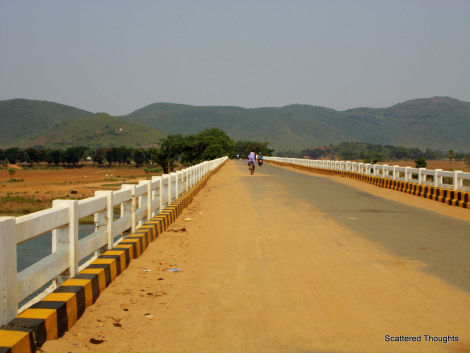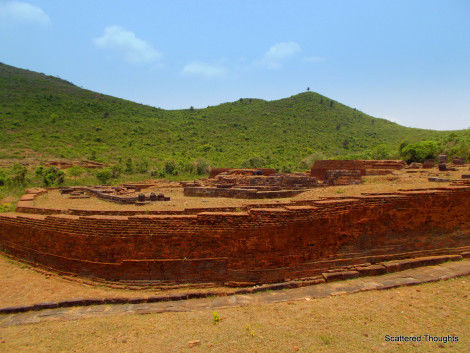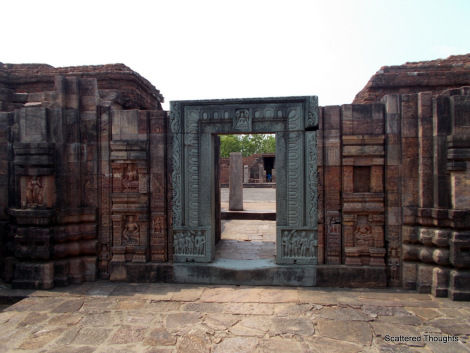

















I have a penchant for traveling. I love to explore the not-so-famous tourist spots with all their serenity and beauty. Recently I visited the three Tantric Buddhist sites of Odisha, Ratnagiri, Udaygiri, and Lalitgiri. The credit for making this tour possible goes to Amrita, a blogger friend, and Odisha Tourism. I won the 2nd prize in a quiz conducted by them and thus proved myself lucky enough to earn a free stay at the Toshali Resorts.
The Tantric, Esoteric or Vajrayāna sect of Buddhism, it is said, first flourished in Bengal and then spread to other states making its impression deepest in Odisha. We can find remains of the Pushphagiri Mahavihara sprawling over the surroundings of the Mahanadi basin and, speaking of the majestic architecture of the Buddhist monastery.
The exquisite chaityas, stupas, and magnificent statues of Lord Buddha have been found in Ratnagiri, Udaygiri, and Lalitgiri; the three hills together called the Diamond Triangle, was the seat of one of the earliest educational centres for higher learning in India along with Nalanda, Vikramshila, and Takshila universities. The mention of Pushphagiri Mahavihara has also been found in the writing of the famous Chinese traveller Hiuen Tsiang (Xuan Zang) in his book Si-Yu-Ki. Hiuen Tsiang visited India around AD 627-643, the Mahavihara flourished from 5th to 11th century AD.
The 70 km road journey from Cuttack to Ratnagiri made us (me and my sister) a bit tired and, after reaching the resort, we decided to take some rest. But, we just passed into a deep slumber post lunch only to wake up in the evening. The next day, early in the morning, we started our journey for the excavated sites. Taking a cue from the map, we decided to start with the farthest one first, the Lalitgiri.
Lalitgiri:“Look within. Be still.Free from fear and attachment,Know the sweet joy of living in the way”
Lalitgiri, one of the three campuses, is adorned with numerous trees, some of which are prehistoric ones, standing tall against the raging tide of time. The verdant vegetation worked as a wonder for us after a short uphill trek. It was extremely hot, but the air up there seemed cool. The Archeological Survey of India (ASI) has done a pretty good job excavating 4 large brick monasteries (perhaps to house the wandering monks during the rainy season), a number of votive stupas (a signature architecture of the Mahavihara), different statues, and a chaityagriha stupa here.
A small one-room museum atop the hill houses stone statues of Buddha in different mudras. Several artifacts made of gold and silver, a stone casket, and statuettes have also been unearthed from the site. Some stone columns have intricate symbols and inscriptions etched on them reminding us many of the unsolved mysteries of the ancient times. However, photography is prohibited inside the Lalitgiri museum.
UdayGiri:“Health, contentment, and trustAre your greatest possessions,And freedom your greatest joy.”
Just like Lalitgiri, Udaygiri is also situated on a small hilltop. The picturesque green valley at once comforts the spectators. At the foothill, there is an ancient step well; bare feet, we went down the staircase, the deep water looked green due to the abundance of algae and scum. A brick pathway by the side of the step well led to the main excavation point. The panoramic view of the green hills offset by the relics and statues made us one with the Nature here. Tranquility and peace prevailed over Udaygiri reminding us of the days when thousands of pupils used to live here making their way to the higher path of learning. Altogether 14 stupas have been unearthed here along with numerous small statues and inscriptions. A local villager guided us as there was no one inside the large ASI compound, he described the historical aspects of the place in broken Hindi and Bengali. The inhabitants, very rightly, take pride to the seat of ancient civilization here.
Ratnagiri:“Be lamps unto yourselves. Be refuges unto yourselves.Take yourself no external refuge.Hold fast to the truth as a lamp.Hold fast to the truth as a refuge.”
The word ‘Ratnagiri’ literally means ‘a hill adorned with jewels’. Perhaps it was the crowning glory of the Pushphagiri Mahavihara and, the largest of the Buddhist monastic settlement found in this area. ASI excavation under the supervision of D.Mitra unveiled the magnificent monasteries, stupas, temples, and votive stupas from under the earth. The Ratnagiri Mahavihara flourished most from the 5th to the 11th century AD in art, architecture and learning. The votive stupas are eloquent proofs of the fact that more than ten thousand students were under the tutelage of Ratnagiri during this time. A sharp decline occurred 13th century onwards perhaps due to lack of royal patronage and because of Muslim invasions in India. Still, it is believed to have survived till 16th century AD. A small trek uphill from the entrance gate took us to the votive stupas. The amazing stone votives with inscriptions and figures stood in neat rows, the distance between them being exactly the same! It’s a wonder with how much precision and accuracy these were made. It is said, students were supposed to build a votive to symbolize the successful completion of learning.
We, the modern erudite people couldn’t even dream of paying such wonderful adulation to our alma-mater.A narrow pathway led us to the main monastery. The green field on one side was resplendent with wildflowers. The existing relics here speak of the magnificence of the monastery. A large stone courtyard lies in the middle with monastic cells all around the porch. The intricate designs of the entablature attest the glory of the Vihara in its heydays.
Directly opposite to the entrance towards the rear end of the courtyard, there is a cell housing a huge statue of Lord Buddha in the Bhumisparsha Mudra. Two male figurines are there on either side of the statue with lotuses and chamars (fans) in their hands. Perhaps this served as an altar. Huge heads of Buddha, statues of Tara, Jambhala, and several other sacred Tantric deities are strewn all over the place. You can feel the awe, the excellence, and the wonder of Ratnagiri here.Standing in the middle of the huge courtyard, with the vast blue sky above, it seemed history came alive to us. It gave me a shiver down the spine to think of those days when India was one of the most revered countries of the world.
The giant Buddha head besides the entrance looked like as if it was healing us from the core. Those lotus eyes still shine with mercy and love spreading ahimsa. You are bound to feel the magic when you’re in Ratnagiri, the divine essence dominating all devilish spirits around. The lush green freshness will rejuvenate your eyes and mind, the somber serenity will provide you a somnolence. The Tantric Buddhist monks wisely chose these places to attain enlightenment through learning while Mother Nature carefully curved her beauty here to match the soulful illumination. I’ve witnessed the past in glimpses of the present. The opulent architecture, the mesmerizing scenic beauty will be in my mind forever.
P.S. There is an air-conditioned museum in Ratnagiri housing over 3000 artifacts that have been excavated from the site is also a must visit.
This trip was originally published on Scattered Thoughts.
Frequent Searches Leading To This Page:-
Offering Honeymoon Package In Orissa, beach honeymoon destinations orissa, honeymoon tours orissa, honeymoon packages enquiry, Honeymoon in Orissa



























